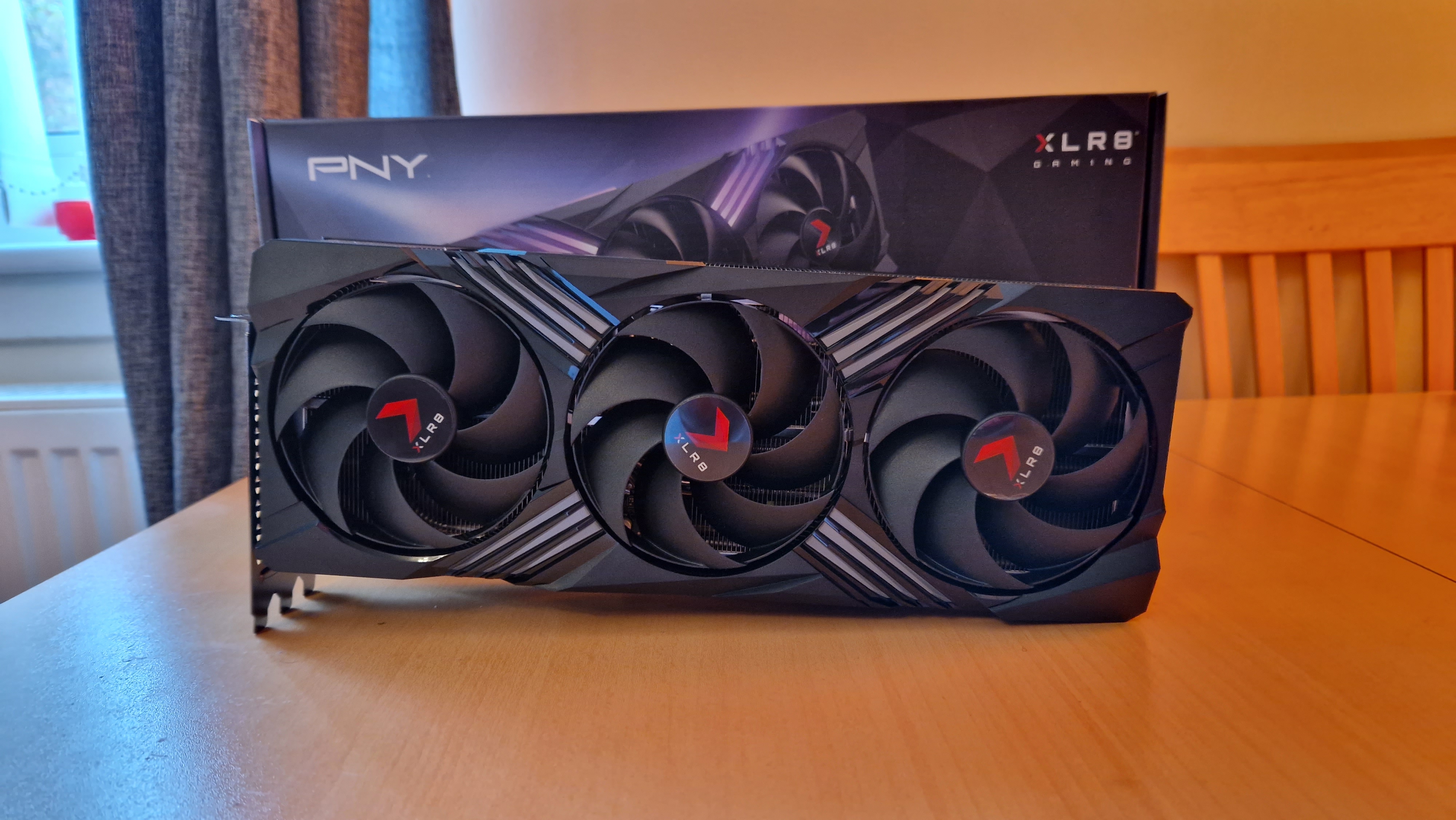GamesRadar+ Verdict
The 4070 Ti feels like the Loki of the GPU world. Under the hood, it's not all that powerful, but it has some clever tricks that it relies on to keep it competitive with other graphics cards. It's a decent card for gaming, but the context behind the RTX 4070 Ti's pricing makes me hesitant to recommend it.
Pros
- +
Alright 4K performance
- +
Better 1440p performance
- +
DLSS 3.0 and ray tracing cores
Cons
- -
AMD's flagships are better, faster, stronger
- -
DLSS 3.0 acts as a get-out-of-jail-free card
- -
Sets a precedent for 40 series over-pricing
- -
12GB is swallowed up easily in 4K
Why you can trust GamesRadar+
When the Nvidia RTX 4070 Ti was first released, I didn't quite understand the controversies surrounding it. It was the "unlaunched" 12GB RTX 4080, yes, but I didn't get why people were so up in arms about it. After all, it'll still give you solid in-game performance at $100 less than the 12GB 4080 was going to. What's there to really be that mad about?
After reviewing both its biggest rivals, the AMD Radeon RX 7900 XTX and RX 7900 XT, in recent weeks, I can now see where people's frustrations truly lie. Any annoyances probably aren't, and shouldn't, be directly to do with the power of this GPU alone, even if it's far from perfect. In fact, annoyances should be about the fact that the 4070 Ti is going to enable Nvidia to continue overcharging gamers for the best graphics cards, and milk its current market position for all its worth.
The price of GPUs is still recovering after years of turmoil. Chip shortages are over, and thankfully, so are the worst days of crypto scalpers throwing a spanner in the works. That said, prices are still yet to come close to actual MSRPs, and what the 4070 Ti has shown me is that Nvidia is quite happy for that to be the case. After all, that's all an MSRP really is these days - a "suggested" retail price and nothing more. Nvidia knows full well that when third-party brands and retailers get a hold of things, GPUs will actually cost a lot more.
The 4070 Ti is "supposed" to cost $799 / £799. At the time of writing, it will actually cost you anywhere between $850 and $900. The PNY model we've tested for this review sits at $850 and £889. That is roughly $50 less than the RX 7900 XT, and that card never needs to use some cheap tricks to stay competitive like this one does.
Design and features
The PNY GeForce RTX 4070 Ti has one of the nicest designs in the 4070 Ti range, in my opinion. It has some flashy RGB lights that blend right in with the best gaming PCs, but still coordinates nicely with the rest of PNY's XLR8 products. There are nice matte black tones and flashes of red, which means it's not too far removed from the brand's PNY XLR8 DDR5 RAM (which our testing PC is still rocking after its review).
Although the 4070 Ti is much bigger than the two RX 7900 models at 13.06 x 5.39 x 2.62 inches, it's surprisingly lighter. Inside the box, you'll be greeted with an anti-sag bracket, which is a nice inclusion, although I managed to install and use the card without needing one. Depending on your case and motherboard, one of these is never a bad idea - you're better safe than sorry.
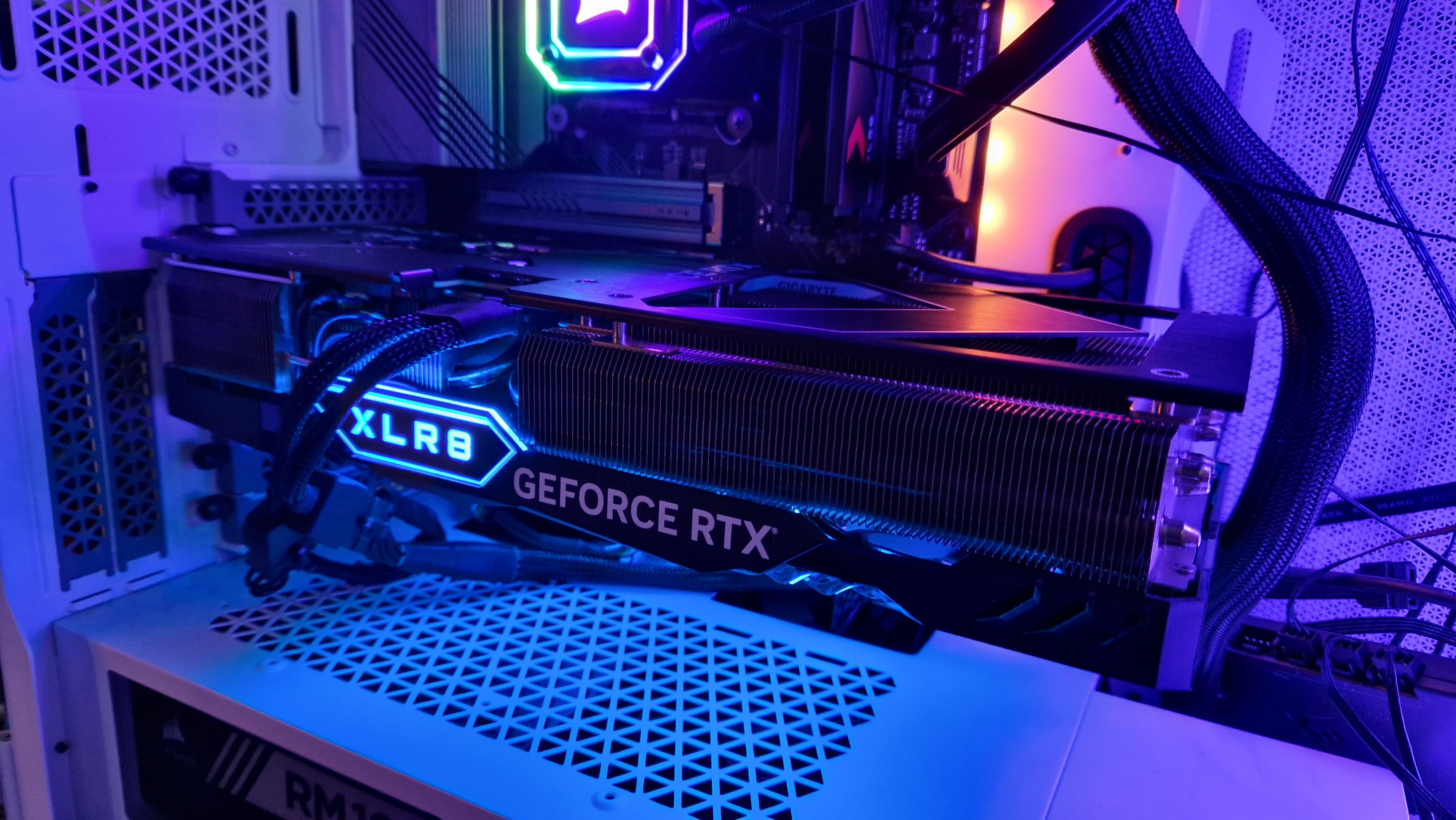
Also in the box, you'll find a cable converter to take a standard 16-pin GPU cable down to the two 8-pin plugs the RTX 40 series has been using. Having read up on these cables, it wasn't as hard to plug in properly as I've heard - just make sure you hear that audible "click" to avoid any spontaneous combustion or melting problems. The cable PNY included in the box was also fairly flexible compared to the options I've seen online, which, to all accounts, don't bend all that easily and can cause issues when pressed against the glass door of one of the best PC cases.
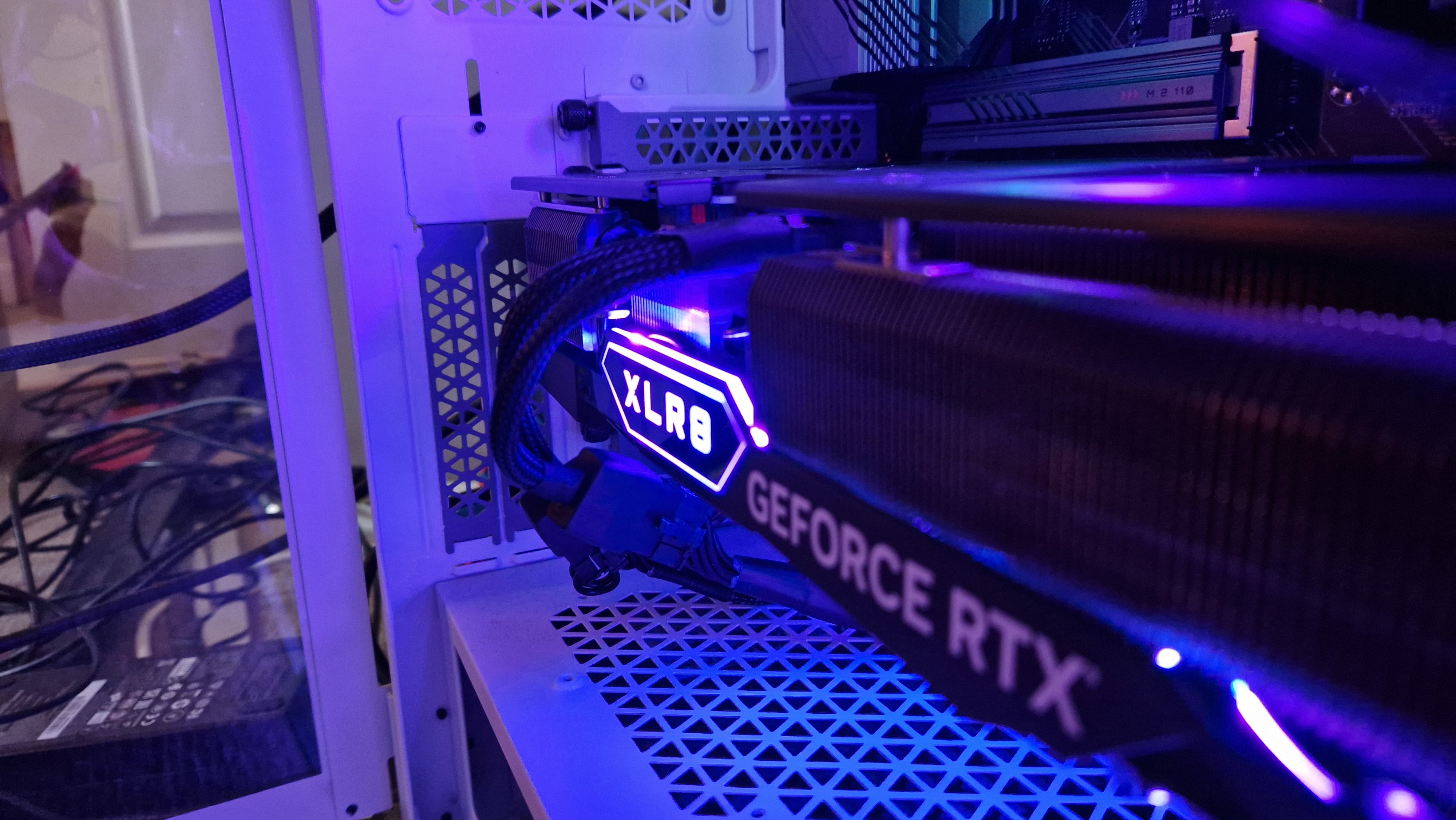
In terms of features, if you're well-read on the 40 series Lovelace architecture, you'll know what to expect. The 4070 Ti has dedicated Tensor and ray tracing cores, 7680 CUDA cores, a speedy quoted clock speed of 2310 MHz, and (famously) 12GB of GDDR6X VRAM. In terms of connectivity, you have three DisplayPorts, and one HDMI 2.1 port.
The most notable of the 4070 Ti's features is DLSS 3.0, which is one of the founding pillars of Nvidia's latest GPU generation. It uses the advanced Lovelace architecture in combination with extremely clever AI that will generate entire frames in games and apps that support it. Seeing it in practice while testing this GPU was quite something, and it adds some serious performance value, frequently acting as a get-out-of-jail-free card in 4K. This feature has never been more important in a 40 series GPU than it is here, but we'll get onto that in a minute.
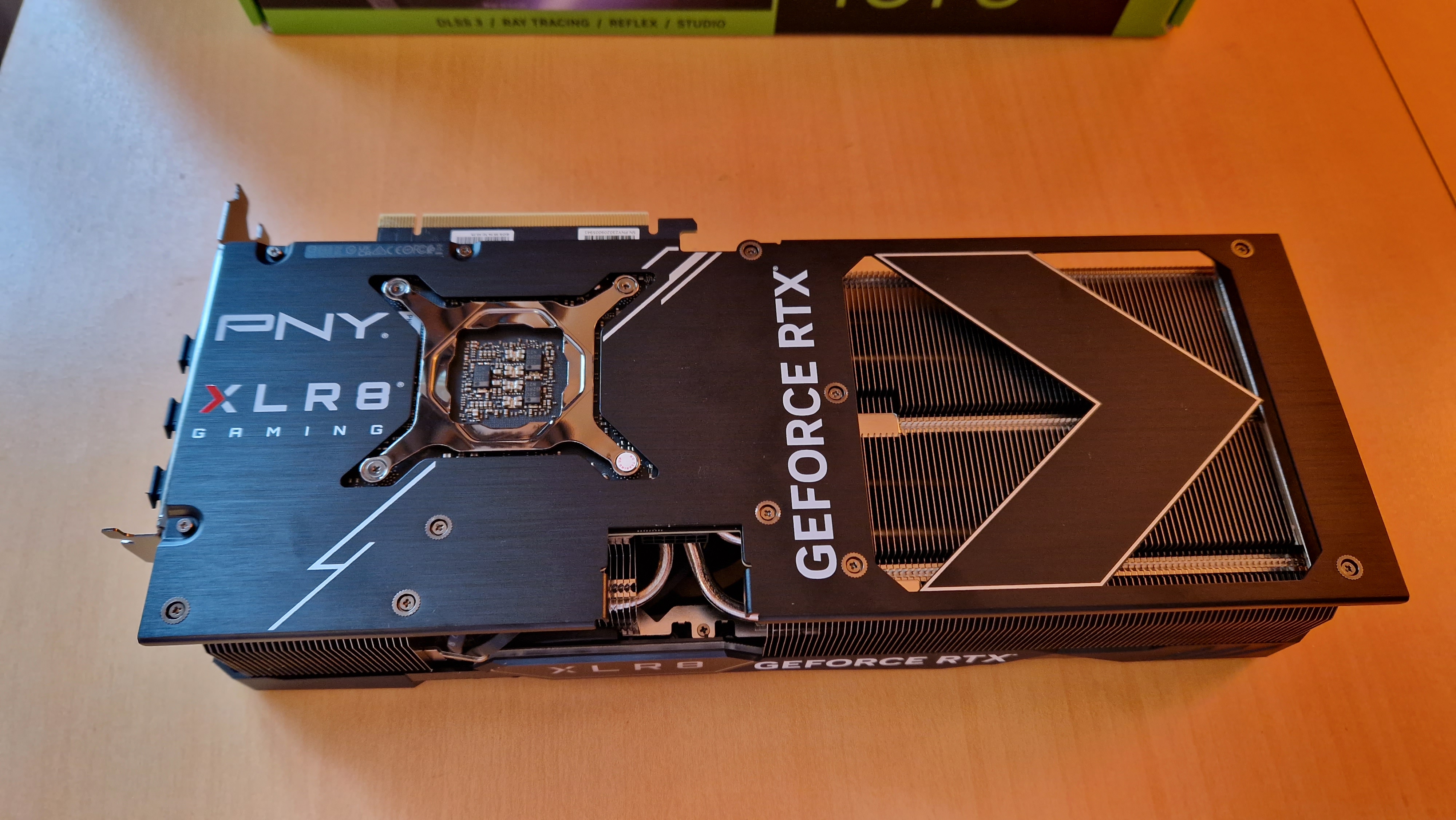
Performance
Although the 4070 Ti was pitched by Nvidia as a 3090 Ti killer, actual performance isn't as clear-cut as that. That marketing line is certainly fair in 1440p, but at 4K, the 4070 Ti's 12GB is swallowed up far too quickly, causing lower frame rates, and more pop-in than you'd want for the price. In some cases, certain settings even have to be dialed back when playing a game in 4K, because the games themselves recommend you have more VRAM in order to ramp them up all the way.
Don't get me wrong, the 4070 Ti does perform great at 1440p, and will absolutely run modern games at reasonable frame rates in 4K, but that is wholly thanks to the fact that it uses the aces up its sleeve to stay competitive. Without DLSS turned on or supported, 4K performance is average at best, and disappointing at worst.
You can see the PNY 4070 Ti's 1440p performance in the table below. These games had all settings turned up to max (where possible), and ray tracing and DLSS turned on.
| Row 0 - Cell 0 | FPS | DLSS | Ray Tracing |
| HUNT: Showdown | 120 | No | No |
| Apex Legends | 225 | No | No |
| Metro Exodus | 120 | Yes | Yes |
| Control | 120 | Yes | Yes |
These are solid 1440p frame rates, although if I'm honest, they weren't exactly as high as I was expecting from the 4070 Ti. These are the sorts of generational leap up I was hoping to see from something like a 4060 or 4060 Ti, especially since these were scores with DLSS turned on (where applicable). I expected higher scores than the RX 7900 XT, which I got to run HUNT: Showdown at 115fps in 1440p max settings, but the 4070 Ti's 120 was only barely quicker. In Apex Legends, the 7900 XT clocked 210fps, again, not too far off considering the massive leaps Nvidia has claimed.
The 7900 XTX, unsurprisingly, was the king at 1440p, getting HUNT up to 150fps at a minimum, and Apex at 250fps.
In 4K, however, we see how important DLSS is in enabling the 4070 Ti to compete with the AMD RX 7900 series.
| Row 0 - Cell 0 | RX 7900 XTX | RX 7900 XT | RTX 4070 Ti |
| HUNT: Showdown | 150 | 95 | 85 |
| Apex Legends | 250 | 160 | 154 |
| Guardians of the Galaxy | 120 | 75 | 96 (115 with DLSS) |
| Metro Exodus | 90 | 72 | 87 (120 with DLSS) |
| Control | 50 | 40 | 30 (70 with DLSS) |
Particularly with the final three games in that table, you can see the power of DLSS. Without it, the 4070 barely runs Control in 4K max settings at a playable level. But with DLSS turned on, there's a sizeable leap in those results, and it's really impressive. It takes a GPU that's struggling to perform and boosts it to a competitive level.
Another thing to note with those three games is that it shows you that Nvidia's GPUs are a step above in terms of ray tracing. Even without DLSS on, the 4070 Ti is able to handle the 4K ray tracing workload more capably than the 7900 XT. However, you can see that the 7900 XT can produce better results in games that don't have DLSS support or ray tracing, such as HUNT and Apex.
For those who like a little more technicality, here are the same GPUs compared, this time in some benchmarking tests in 3DMark and Geekbench.
| Row 0 - Cell 0 | 3DMark Time Spy (graphics score) | 3DMark Fire Strike | Geekbench OpenCL GPU compute | Geekbench Vulkan GPU compute |
| PNY RTX 4070 Ti | 22 793 | 38 042 | 216377 | 168626 |
| AMD RX 7900 XTX | 28 011 | 40 392 | 222987 | 209630 |
| AMD RX 7900 XT | 24 326 | 40 425 | 193584 | 202062 |
Although these marks are still good, and enough to pull through overall "legendary" status in the 3DMark tests, across the board the 4070 Ti scores lower than both flagship AMD cards. The one exception is obviously Geekbench's OpenCL GPU compute test, where the 4070 Ti narrowly outperformed the 7900 XT, but still fell short of the XTX.
So overall, performance is good with the 4070 Ti both technically and when gaming. In 1440p and 4K, you'll get playable frame rates, despite 4K requiring some DLSS boosting.
From a more holistic point of view, I preferred using both of the AMD graphics cards, and I think either one would be my go-to choice over the 4070 Ti if I was to buy a new-gen card tomorrow. Yes, DLSS is a mammoth feature that gives a serious boost to games that allow it to, but in terms of pure power, I think the AMD options will give more future-proofing and more consistent performance, not to mention value for money.
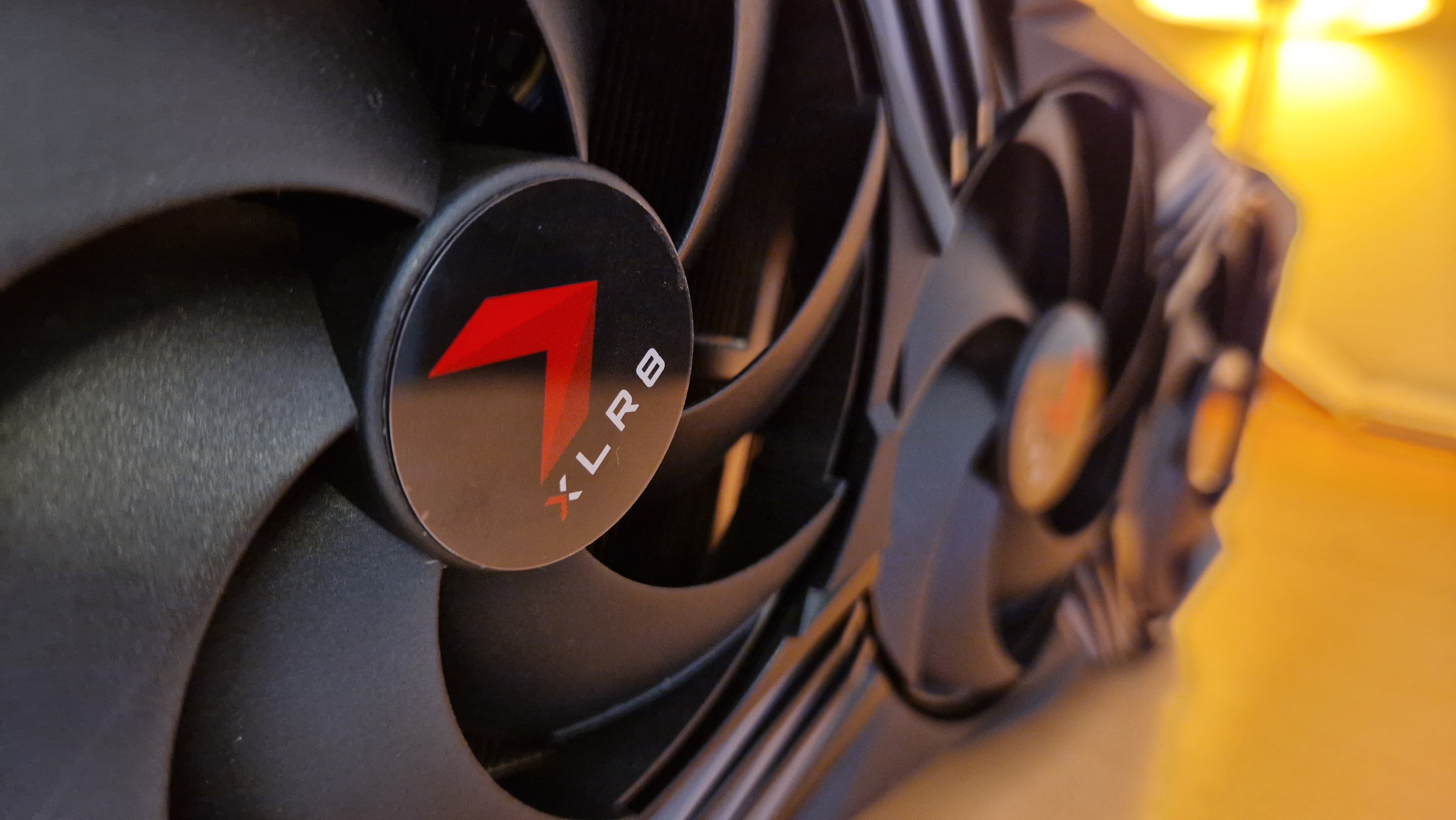
Should you buy the PNY RTX 4070 Ti?
If you want access to the kind of graphical settings a card of this price is supposed to offer you, DLSS is a necessity for the 4070 Ti. Its only other saving grace in 4K is the clever architecture and dedicated RT cores which means it handles ray tracing more efficiently than the competition.
It may sound ridiculous, but without these two aces up the 4070 Ti's sleeve, there are cheaper Xboxes and a PlayStation 5 that can offer you more consistent native 4K performance for so much cheaper.

The 4070 Ti feels like a seedy stockbroker who uses cheap tricks to hide his fraud. DLSS is a get-out-of-jail-free card that will frequently bail out the 12GB of GDDR6, and Nvidia's flagship ray tracing capabilities keep AMD's SEC investigators at bay. Despite the impressive parlor tricks, I can't recommend you buy it over the AMD 7900 XT and XTX. Although those cards are both more expensive, they offer more consistent 4K power, and more importantly, allow you to vote with your wallet.
If you think that GPUs are too expensive, tell Nvidia that you won't support its price-hiking by going to a very worthy competitor. AMD isn't exactly pricing cheaply either, but I'm choosing to give it the benefit of the doubt because it's the company that's trying to win back its position in the market. I think if Nvidia started its 40 series pricing lower down the ladder, AMD would always have undercut it.
Any way I look at it, the 4070 Ti sets an unfriendly precedent for Nvidia to keep prices higher than necessary. When the 4080 12GB was "unlaunched" and repurposed into the 4070 Ti, it was given a $100 price drop despite being completely unchanged. So, if team green is still making a profit after charging $100 under what it wanted to, just how much is it going to price hike the upcoming mid-range cards?
How we tested the PNY GeForce RTX 4070 Ti
I put the PNY RTX 4070 Ti to work in our trustee testing PC to see how it performed. I played games predominantly at 1440p, as I found this was where the GPU worked the best, and most consistently across the board. I played various games with different technical specifications and demands.
Two of these were HUNT: Showdown and Apex Legends - competitive shooters where the goal is to get as many frames per second as possible when DLSS wasn't in-play. Ray tracing also wasn't a factor in one of these games, although was in Apex. Other than that, I used Metro Exodus, Control, and Guardians of the Galaxy to test ray tracing and DLSS.
I closely compared my time with the 4070 Ti to both AMD flagship GPUs, since I reviewed these in the last month, and they're the closest market competitor to the 4070 Ti. Lastly, I used Geekbench and 3DMark to get benchmark scores in the same tests the AMD options underwent.
For reference, our testing rig has a Gigabyte Z690 Gaming X motherboard, PNY XLR8 DDR5 RAM, an RM1000X power supply, and an Intel i7-12700K CPU.
If you'd like to read more about our holistic approach to reviewing the latest gaming technology, have a gander at our Hardware Policy.
Gear up for some new-gen PC components with the best 4K monitor, the best high refresh rate monitor, and the best gaming keyboard.
One of my earliest memories is playing SuperMario64 and wondering why the controller I held had three grips, but I only had two hands. Ever since I've been in love with video games and their technology. After graduating from Edinburgh Napier University with a degree in Journalism, I contributed to the Scottish Games Network and completed an Editorial Internship at Expert Reviews. Over the last decade, I’ve been managing my own YouTube channel about my love of games too. These days, I'm one of the resident hardware nerds at GamesRadar+, and I take the lead on our coverage of gaming PCs, VR, controllers, gaming chairs, and content creation gear. Now, I better stop myself here before I get talking about my favourite games like HUNT: Showdown, Dishonored, and Towerfall Ascension.
